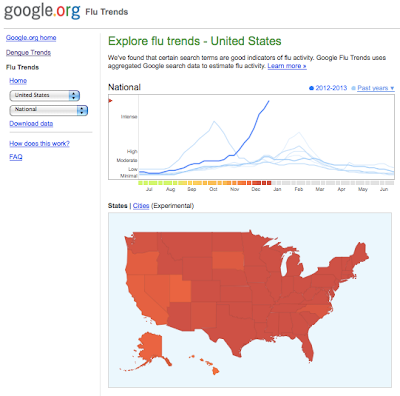* Scientists see link in depression and four other disorders: Five disparate mental-health disorders may have a common genetic link, according to a new study that's getting lots of attention. The research has found that a number of genes are shared by people who have major depression, bipolar disorder, schizophrenia, autism, and attention-deficit hyperactivity disorder. The study was published in the edition of The Lancet publishing on Wednesday (abstract).
The researchers found that "four spots in the genome that were more common among those with psychiatric disease, two of which occurred in genes involved in communication between brain cells," according to an article in the Boston Globe. Also, "They also found that genetic risk factors for bipolar disorder and schizophrenia had the most overlap."
They also
found that genetic risk factors for bipolar disorder and schizophrenia
had the most overlap. - See more at:
http://www.boston.com/news/science/blogs/science-in-mind/2013/02/27/autism-schizophrenia-and-other-psychiatric-disorders-share-genetic-underpinnings/I5Rdy7NikMlFvTe8d9BXoL/blog.html#sthash.iwHOygA5.dpuf
They also
found that genetic risk factors for bipolar disorder and schizophrenia
had the most overlap. - See more at:
http://www.boston.com/news/science/blogs/science-in-mind/2013/02/27/autism-schizophrenia-and-other-psychiatric-disorders-share-genetic-underpinnings/I5Rdy7NikMlFvTe8d9BXoL/blog.html#sthash.iwHOygA5.dpuf
four spots
in the genome that were more common among those with psychiatric
disease, two of which occurred in genes involved in communication
between brain cells. - See more at:
http://www.boston.com/news/science/blogs/science-in-mind/2013/02/27/autism-schizophrenia-and-other-psychiatric-disorders-share-genetic-underpinnings/I5Rdy7NikMlFvTe8d9BXoL/blog.html#sthash.iwHOygA5.dpuf
found
four spots in the genome that were more common among those with
psychiatric disease, two of which occurred in genes involved in
communication between brain cells.
They also found that genetic risk factors for bipolar disorder and schizophrenia had the most overlap.
- See more at:
http://www.boston.com/news/science/blogs/science-in-mind/2013/02/27/autism-schizophrenia-and-other-psychiatric-disorders-share-genetic-underpinnings/I5Rdy7NikMlFvTe8d9BXoL/blog.html#sthash.iwHOygA5.dpuf
found
four spots in the genome that were more common among those with
psychiatric disease, two of which occurred in genes involved in
communication between brain cells.
They also found that genetic risk factors for bipolar disorder and schizophrenia had the most overlap.
- See more at:
http://www.boston.com/news/science/blogs/science-in-mind/2013/02/27/autism-schizophrenia-and-other-psychiatric-disorders-share-genetic-underpinnings/I5Rdy7NikMlFvTe8d9BXoL/blog.html#sthash.iwHOygA5.dpuf
found
four spots in the genome that were more common among those with
psychiatric disease, two of which occurred in genes involved in
communication between brain cells.
They also found that genetic risk factors for bipolar disorder and schizophrenia had the most overlap.
- See more at:
http://www.boston.com/news/science/blogs/science-in-mind/2013/02/27/autism-schizophrenia-and-other-psychiatric-disorders-share-genetic-underpinnings/I5Rdy7NikMlFvTe8d9BXoL/blog.html#sthash.iwHOygA5.dpufTelepathic rats? See for yourself.
* "First mind-reading implant gives rats telepathic power": Now there's a headline that'll get your attention. The New Scientist articles reports that "The world's first brain-to-brain connection has given rats the power to communicate by thought alone."
Although this is an exciting development in brain research (rats on different continents were even able to communicate via the Internet), the article notes that "the exact information being communicated between the rats' brains is not clear."
* Tech giants seek public's help for cancer cure: British cancer researchers are joining forces with Google, Amazon.com, and Facebook to enlist the public's assistance in finding cures for cancer. Cancer Research U.K. is teaming up with the tech firms to get the public to perform tasks that can help in efforts such as "working out the exact sequence of a tumor's DNA,"according to a BBC News article.
Programmers, game designers, and others are set to meet this week to figure out how to create a game-life way to put the collective eyeballs and computer power of everyday citizens to solve problems in cancer research. The concept is similar to volunteer-computer efforts from the BOINC project, such as SETI@Home and medical-related endeavors such as RNA World and Malariacontrol.net. It's hoped the project will be up and running by summer.
* Coronary calcium indicates stroke risk: A coronary artery calcification score can predict the risk of stroke, independent of other factors, at least in cases of people with lower risk of cardiovascular disease. An article in MedPage Today says that this may or may not change how clinicians work, since it's already been established that stroke and coronary artery disease have some of the same disease processes.
What's more, the measure of calcification is done by an electron-beam CT scan, so any potential benefit of the rest must be weighed against the additional radiation exposure.

